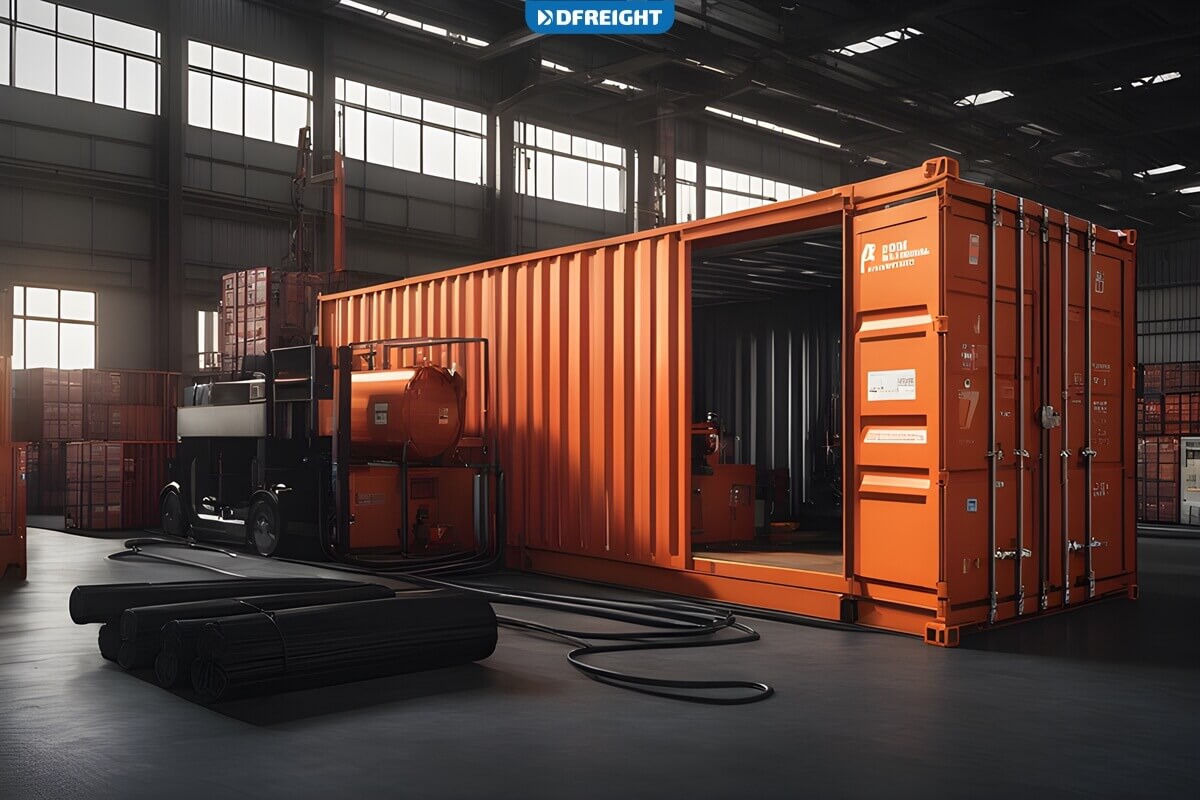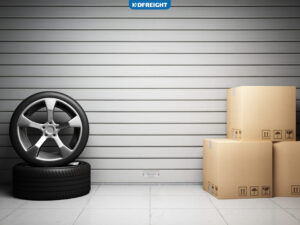Welcome to our comprehensive guide on the intricate process of shipping electrical and plumbing equipment. From ensuring safe packaging to navigating international shipping, we’ll provide you with expert insights and strategies for successful delivery. Whether you’re a business or an individual, this guide will equip you with the knowledge to streamline your shipping operations and ensure your equipment reaches its destination in top condition. Let’s dive into the world of effective shipping practices for these essential items.
Ready to simplify your shipping process and ensure the safe transportation of your electrical and plumbing equipment? Look no further than DFreight, your trusted freight forwarder expert in this field. With our cutting-edge online platform, you can enjoy seamless booking, real-time tracking, and access to a global network of reliable carriers. Whether you’re shipping domestically or internationally, DFreight has the expertise and resources to handle your shipments with utmost care and efficiency.
Table of Contents
Common Challenges in Shipping Electrical and Plumbing Equipment
Shipping electrical and plumbing equipment poses unique challenges that demand attention and specialized handling. Here are some of the common challenges faced:
- Fragile Components: Electrical and plumbing equipment often contain fragile components that require delicate handling. Vibrations, drops, or even slight impacts can result in irreparable damage.
- Weight and Size: Many electrical and plumbing items can be heavy and bulky, making them susceptible to mishandling or damage due to their size.
- Sensitivity to Environmental Factors: Temperature, humidity, and exposure to moisture can adversely affect certain equipment. Without proper protection, these elements may lead to equipment malfunction or corrosion.
- Complex Assemblies: Some equipment includes intricate assemblies that must remain intact during shipping. Dislodgment or misalignment can lead to malfunctions and require expert intervention for repair.
- Transit Time: Prolonged transit times increase the probability of incidents during shipping. This is especially concerning when shipping internationally or across long distances.
- Stacking and Storage: Improper stacking or storage of packages during shipping can result in crushing or impact damage to delicate equipment.
Addressing these challenges requires a combination of appropriate packaging materials, cushioning, labeling, and working with reliable shipping carriers that understand the sensitivity of such cargo.
Preparing the Equipment for Shipping
Shipping electrical and plumbing equipment requires meticulous preparation to ensure safe and secure transportation. Properly preparing the equipment involves several crucial steps, including cleaning and disassembling, removing hazardous materials (if applicable), and choosing the right packaging materials. Let’s delve into each of these aspects:
- Cleaning and Disassembling:
Before shipping electrical and plumbing equipment, it is essential to clean and disassemble the items whenever possible. Cleaning the equipment serves multiple purposes:
a. Removal of Dust and Debris: Cleaning helps eliminate dust, dirt, and debris that may have accumulated on the equipment during use or storage. This prevents potential damage during transportation and ensures that the equipment arrives in a presentable condition.
b. Corrosion Prevention: For plumbing equipment or components exposed to moisture, cleaning helps prevent corrosion and extends their lifespan.
c. Improved Aesthetics: Properly cleaned equipment leaves a positive impression on the recipient, especially in cases where the items are intended for sale or public display.
Disassembling the equipment, when feasible, also offers benefits:
a. Reducing Risk of Damage: Some components may be delicate or prone to damage during transit. Disassembling them and securely packaging each part can minimize the risk of breakage.
b. Space Optimization: Smaller components can be packed more efficiently, optimizing space and potentially reducing shipping costs.
- Removing Hazardous Materials (if applicable):
Certain electrical and plumbing equipment may contain hazardous materials or substances that require careful handling and disposal. Following the appropriate guidelines and safety protocols is crucial if you are shipping items that fall under hazardous materials regulations. These materials may include batteries, certain chemicals, or refrigerants found in appliances like air conditioners or refrigerators.
Before shipping, ensure you comply with local and international hazardous material handling, labeling, and documentation regulations. If you are unsure about the presence of hazardous materials in the equipment, consult with the manufacturer or a professional to identify and handle them correctly.
- Choosing the Right Packaging Materials:
Selecting suitable packaging materials is critical to safely transporting electrical and plumbing equipment. Here are some considerations:
a. Sturdy Boxes or Containers: Use strong and durable boxes or containers that can withstand the weight and dimensions of the equipment. Reinforced cardboard boxes or wooden crates are commonly used for heavier or bulkier items.
b. Protective Padding and Cushioning: Employ appropriate cushioning materials such as foam, bubble wrap, or packing peanuts to protect the equipment from shocks, vibrations, and impacts during transit.
c. Secure Fastening: Ensure that the equipment is securely fastened inside the packaging to prevent movement or shifting during shipping.
d. Customized Packaging: For irregularly shaped equipment, consider customizing packaging to provide a snug and secure fit.
e. Hazard Labels (if applicable): If shipping hazardous materials, affix the necessary hazard labels and markings on the packaging as required by regulations.
f. Weatherproofing: If the equipment is sensitive to moisture or weather conditions, use weatherproof packaging or moisture barriers to protect it from the elements.
Cleaning and disassembling the equipment, removing hazardous materials (if applicable), and carefully selecting appropriate packaging materials significantly increase the chances of a successful and damage-free shipping experience. Taking these preparation steps will not only safeguard the equipment but also ensure customer satisfaction, protect your brand reputation, and save you from potential losses associated with damaged goods.
Choosing the Right Shipping Method
When shipping electrical and plumbing equipment, selecting the right shipping method is crucial to ensure timely delivery, cost-effectiveness, and the safe transportation of the items. Various shipping methods are available, and each has advantages and considerations. Here are the key factors to consider when choosing the appropriate shipping method:
- Freight vs. Parcel Shipping
Freight Shipping:
- Suitable for large and heavy equipment or bulk shipments.
- Typically used for commercial or industrial purposes.
- Offers cost-effective pricing for heavyweight or oversized cargo.
- Freight carriers may offer additional services, such as liftgate delivery or inside delivery.
- Longer transit times may be expected for ground freight, especially for long distances.
Parcel Shipping:
- Ideal for smaller and lighter items or packages.
- Convenient for individual or small-scale shipments.
- Provides faster transit times, especially for express services.
- Usually offers door-to-door delivery with tracking capabilities.
- Parcel shipping is often more expensive for heavy or bulky items.
The choice between freight and parcel shipping depends on the size, weight, and volume of the electrical and plumbing equipment, as well as the urgency of the delivery.
- Domestic vs. International Shipping Considerations
Domestic Shipping:
- Relatively simpler shipping process within the same country.
- Generally shorter transit times and fewer customs-related delays.
- The pricing may vary based on distance and the shipping provider.
International Shipping:
- Involves complex customs procedures, documentation, and regulations.
- Longer transit times due to customs clearance and potential distance.
- Additional costs such as import duties, taxes, and brokerage fees may be incurred.
- International shipping requires accurate documentation and adherence to destination country regulations.
Before choosing international shipping, it’s essential to research and understand the customs regulations, duties, and taxes associated with the destination country to avoid unexpected delays and costs.
- Expedited Shipping Options
- Provides faster delivery times compared to standard shipping options.
- Ideal for urgent shipments or time-sensitive equipment.
- Available for both freight and parcel shipments, but additional fees apply.
- Express or overnight options may be available for domestic and international shipping.
- Expedited shipping can be costly, so it’s essential to weigh the urgency of the shipment against the added expense.
Expedited shipping is beneficial when meeting tight deadlines is critical, such as supplying essential equipment to customers or completing urgent projects.
In conclusion, choosing the right shipping method for electrical and plumbing equipment involves evaluating factors like the size and weight of the items, shipping distance, urgency, and whether it’s a domestic or international shipment. Freight shipping is suitable for large or heavy equipment, while parcel shipping is ideal for smaller items. For international shipping, consider the complexity of customs procedures and associated costs. Expedited shipping provides quicker delivery but comes with additional expenses. By carefully considering these factors, you can make an informed decision that ensures efficient and cost-effective shipping for your equipment.
Shipping Insurance and Liability
Shipping electrical and plumbing equipment involves inherent risks, and unforeseen accidents or mishaps can lead to damages or losses during transit. Shipping insurance provides valuable coverage to protect against such occurrences, and understanding its scope is essential for shippers and recipients. Additionally, knowing how to handle damages or losses effectively is crucial to ensure a smooth resolution. Let’s explore both aspects in detail:
- Understanding Shipping Insurance Coverage
Shipping Insurance
- Shipping insurance is a policy that offers financial protection against damages, losses, or theft that may occur during transportation.
- It provides coverage for the declared value of the shipment, which is usually determined by the sender based on the item’s actual worth.
- The cost of shipping insurance typically depends on the equipment’s value and the required coverage level.
Types of Shipping Insurance:
- Full Coverage: Provides reimbursement for the full declared value of the equipment in case of total loss or irreparable damage during transit.
- Limited Coverage: Offers partial reimbursement up to a predetermined limit in case of damages or loss.
- Carrier Liability: Carriers may offer limited liability coverage as part of their standard shipping services. However, this coverage is often minimal and may not fully compensate for the actual value of the equipment.
It’s important to carefully read and understand the terms and conditions of the shipping insurance policy, including any exclusions or limitations, before opting for coverage.
- Dealing with Damages or Losses
Despite taking precautions and having insurance coverage, damages or losses can still occur during shipping. Here’s how to handle such situations effectively:
- Inspect Upon Arrival: Upon receipt of the shipment, inspect the equipment immediately for any visible damages or signs of tampering. Note any damages on the delivery receipt or waybill, and take photographs as evidence if possible.
- Contact the Carrier: If damages or losses are evident, immediately report the issue to the carrier or shipping company. Provide them with the necessary documentation and evidence, such as photographs and the packing list.
- File a Claim: Start the freight claims process with the carrier or the shipping company’s customer service. Complete any required claim forms and provide all supporting documents to expedite the claim.
- Keep Records: Keep copies of all documentation related to the shipment, including the bill of lading, packing list, invoices, and the shipping insurance policy.
- Cooperate in Investigations: In some cases, the carrier or insurance provider may investigate the extent of the damages or loss. Cooperate fully during this process to expedite the claim resolution.
- Follow Up: Stay in communication with the carrier or insurance provider throughout the claims process to ensure a prompt resolution.
Shipping insurance provides peace of mind and financial protection against unforeseen events during transit. By promptly addressing damages or losses and following the proper claims procedure, you can work towards a satisfactory resolution and recover the value of the equipment or its replacement.
International Shipping Considerations
Shipping electrical and plumbing equipment internationally involves navigating various complexities and complying with country-specific regulations. Understanding the key considerations, such as customs regulations and restrictions, duties and taxes, and dealing with language barriers, is crucial to ensure a smooth and successful international shipping process. Let’s explore each of these aspects in detail:
Customs Regulations and Restrictions
Customs regulations vary from country to country, and it is essential to research and understand the specific requirements of the destination country before shipping. Some important considerations include:
- Prohibited and Restricted Items: Different countries have lists of prohibited and restricted items that cannot be imported or require special permits. Ensure the shipped electrical and plumbing equipment complies with the destination country’s regulations.
- Required Documentation: Prepare all necessary shipping documentation, including the commercial invoice, packing list, bill of lading, and any additional certificates or permits required by customs.
- Harmonized System (HS) Codes: Assign the correct HS code to the equipment for customs classification and to determine applicable duties and taxes.
- Declared Value: Accurately declare the value of the shipment, as customs duties and taxes are often based on the declared value.
- Preparing for Inspection: Be aware that customs authorities may inspect the shipment, and the equipment should be properly packaged to facilitate examination without damage.
Duties and Taxes
Import duties and taxes are imposed by the destination country’s customs authorities on goods entering their territory. Consider the following:
- Import Duties: These are tariffs or taxes levied on imported goods and vary based on the HS code, country of origin, and declared value of the equipment.
- Value Added Tax (VAT) or Goods and Services Tax (GST): Some countries impose a consumption tax on imported goods, known as VAT or GST. It is calculated as a percentage of the total value, including the import duties.
- Customs Brokerage: Working with a customs broker can help navigate the complexities of duties and taxes, ensuring compliance with regulations and avoiding potential delays or penalties.
- Prepayment of Duties and Taxes: Consider prepaying duties and taxes to expedite the customs clearance process and avoid additional fees upon delivery.
Dealing with Language Barriers
Language barriers can pose challenges in international shipping. Here are some strategies to overcome them:
- Use Bilingual Shipping Documents: Prepare shipping documents in English and the destination country’s language to facilitate customs clearance.
- Communication with Carriers: Ensure shipping carriers have multilingual customer service representatives to assist with language-related issues.
- Work with International Freight Forwarders: International freight forwarders are experienced in dealing with cross-border shipments and can act as intermediaries, handling communication and documentation in the destination country’s language.
- Translations and Interpretation: If needed, consider hiring professional translators or interpreters to assist with communication during shipping.
By carefully considering customs regulations and restrictions, understanding duties and taxes, and proactively addressing language barriers, you can enhance the efficiency of international shipping for electrical and plumbing equipment. Considering these considerations helps minimize potential delays, avoid compliance issues, and ensure successful delivery to the international destination.
Selecting a Reliable Shipping Carrier
Picking a trustworthy shipping carrier is crucial for safe and efficient electrical and plumbing gear transport. Among numerous options, researching, comparing, and evaluating services is key. Reviews offer insights into reliability. Here are the key steps:
Research and Compare
- Service Coverage: Confirm delivery to your destination. Some specialize locally, others globally.
- Shipping Options: Assess choices like standard, expedited, air, or sea. Match your needs.
- Tracking: Ensure real-time tracking for you and your customers.
- Insurance: Ask about coverage for peace of mind.
- Packaging: Some assist in safe packaging.
- Support: Check responsiveness for queries.
- Pricing: Compare rates and fees.
Reviews and Testimonials
- Online Feedback: Learn from customer reviews.
- Testimonials: Seek direct experiences from clients.
- Reputation: Research industry standing.
- Issue Handling: See how they address problems.
- Recommendations: Get word-of-mouth referrals.
Reliable shipping demands careful research. Compare, review, and consider services and reputation for a smooth experience with your equipment.
Experience the convenience and peace of mind that comes with working with a leading freight forwarder. Visit our website now to learn more about our services and get started with DFreight today. Your shipping success is just a click away!
Elevate Your Shipping with DFreight: Experience Efficiency and Reliability!
In conclusion, mastering the art of shipping electrical and plumbing equipment is essential for a seamless and successful supply chain. From packaging to documentation, from tracking to troubleshooting, this guide has equipped you with a comprehensive toolkit to navigate the complexities of shipping. By implementing these best practices and strategies, you can ensure your equipment reaches its intended destination safely, efficiently, and with the utmost care. Remember, a well-executed shipping process safeguards your products and enhances your reputation and customer satisfaction. Embrace these insights and embark on a journey of hassle-free shipping for your valuable equipment.
What considerations should I keep in mind when packaging electrical and plumbing equipment for shipping?
Proper packaging is crucial. Ensure items are securely wrapped, sensitive components are padded, and hazardous materials are handled according to regulations.
Are there specific regulations for international electrical and plumbing equipment shipping?
Yes, customs regulations and import/export restrictions vary by country. Research destination country requirements and provide accurate documentation.
How can I track the progress of my shipped electrical and plumbing equipment?
Most carriers offer tracking services. Use provided tracking numbers to monitor the shipment’s real-time status and estimated delivery time.
What should I do if my electrical or plumbing equipment arrives damaged or lost?
Take photos, report the issue to the carrier, and initiate the claims process immediately. Shipping insurance may cover the value of damaged or lost items.
Can I negotiate shipping rates to make the process more cost-effective?
Negotiating rates with carriers based on your shipping volume and needs is common. It can lead to better cost savings and more favorable terms for your shipments.














